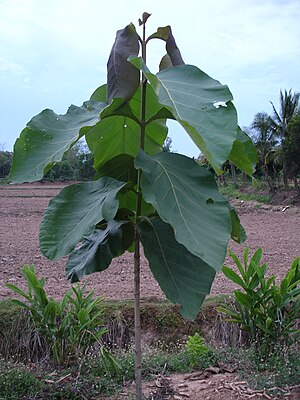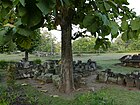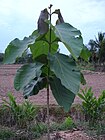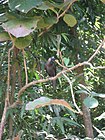Note: This is a project under development. The articles on this wiki are just being initiated and broadly incomplete. You can Help creating new pages.
Tectona grandis
Teak is a large, mainly deciduous tree reaching over 30 metres in height in favourable conditions with an open crown that has many small branches. The bole, which can be unbranched for up to 15 metres, is up to 1 metre in diameter and is often buttressed and may be fluted. In seasonal climates, the tree is deciduous, whilst trees grown in non-seasonal climates are semi-deciduous. This plant belongs to verbenaceae family.
Contents
- 1 Uses
- 2 Parts Used
- 3 Chemical Composition
- 4 Common names
- 5 Properties
- 6 Habit
- 7 Identification
- 8 List of Ayurvedic medicine in which the herb is used
- 9 Where to get the saplings
- 10 Mode of Propagation
- 11 How to plant/cultivate
- 12 Commonly seen growing in areas
- 13 Photo Gallery
- 14 References
- 15 External Links
Uses
Tooth aches, Swelling, Eczema, Ringworms, Inflammation, Bronchitis, Biliousness, Uinary disorders.[1]
Parts Used
Chemical Composition
Naphthoquinones, anthraquinones and isoprenoid quinones are abundant metabolites in teak. In addition to these, teak contains several other phytochemicals such as triterpenoids, steroids, lignans, fatty esters and phenolic compounds.[2]
Common names
| Language | Common name |
|---|---|
| Kannada | Tega, Saaguvaani |
| Hindi | Sagvan |
| Malayalam | |
| Tamil | Tekku |
| Telugu | Peddateku |
| Marathi | |
| Gujarathi | |
| Punjabi | |
| Kashmiri | |
| Sanskrit | Saka, Shaaka |
| English | Teak |
Properties
Reference: Dravya - Substance, Rasa - Taste, Guna - Qualities, Veerya - Potency, Vipaka - Post-digesion effect, Karma - Pharmacological activity, Prabhava - Therepeutics.
Dravya
Rasa
Guna
Veerya
Vipaka
Karma
Prabhava
Habit
Identification
Leaf
| Kind | Shape | Feature |
|---|---|---|
Flower
| Type | Size | Color and composition | Stamen | More information |
|---|---|---|---|---|
| {{{5}}} |
Fruit
| Type | Size | Mass | Appearance | Seeds | More information |
|---|---|---|---|---|---|
Other features
List of Ayurvedic medicine in which the herb is used
Where to get the saplings
Mode of Propagation
How to plant/cultivate
A plant of the tropics, where it is found at elevations from sea level to 1,200 metres. It is able to survive and grow under a wide range of climatic and edaphic conditions, but grows best in a warm, moist, tropical climate with a significant difference between dry and wet seasons.[5]
Commonly seen growing in areas
Photo Gallery
References
- ↑ Indian Medicinal Plants by C.P.Khare
- ↑ Chemical constituents
- ↑ Cite error: Invalid
<ref>tag; no text was provided for refs namedCommon names - ↑ [Morphology]
- ↑ Cultivation
Cite error: <ref> tag with name "Commona names" defined in <references> is not used in prior text.
Cite error: <ref> tag with name "Plant family" defined in <references> is not used in prior text.
External Links
- Pages with reference errors
- Ayurvedic Herbs known to be helpful to treat Tooth aches
- Ayurvedic Herbs known to be helpful to treat Swelling
- Ayurvedic Herbs known to be helpful to treat Eczema
- Ayurvedic Herbs known to be helpful to treat Ringworms
- Ayurvedic Herbs known to be helpful to treat Inflammation
- Ayurvedic Herbs known to be helpful to treat Bronchitis
- Ayurvedic Herbs known to be helpful to treat Biliousness
- Ayurvedic Herbs known to be helpful to treat Uinary disorders
- Herbs with Leaves used in medicine
- Herbs with stem used in medicine
- Herbs with leaves used in medicine
- Herbs with Root used in medicine
- Herbs with common name in Kannada
- Herbs with common name in Hindi
- Herbs with common name in Tamil
- Herbs with common name in Telugu
- Herbs with common name in Sanskrit
- Herbs with common name in English
- Habit - Deciduous tree
- Index of Plants which can be propagated by Seeds
- Herbs that are commonly seen in the region of Tropical deciduous forests
- Herbs






